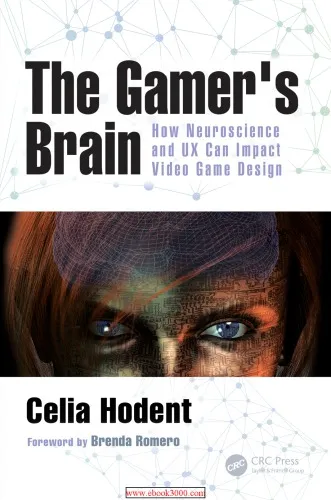The Gamer’s Brain: How Neuroscience and UX Can Impact Video Game Design
4.6
بر اساس نظر کاربران

شما میتونید سوالاتتون در باره کتاب رو از هوش مصنوعیش بعد از ورود بپرسید
هر دانلود یا پرسش از هوش مصنوعی 2 امتیاز لازم دارد، برای بدست آوردن امتیاز رایگان، به صفحه ی راهنمای امتیازات سر بزنید و یک سری کار ارزشمند انجام بدینمعرفی کتاب
کتاب The Gamer’s Brain: How Neuroscience and UX Can Impact Video Game Design نوشته سلیا هودنت، یکی از منابع ارزشمند و منحصربهفرد در حوزه طراحی بازی است که روانشناسی، علوم اعصاب و اصول UX (تجربه کاربری) را به طور حرفهای و علمی با طراحی بازیهای ویدیویی پیوند میدهد. این کتاب با تاکید بر ارتباط بین شناخت انسان و طراحی بازی، یک راهنمای جامع برای توسعهدهندگان بازیهای ویدیویی، روانشناسان و افرادی که به دنبال درک بهتر نحوه تعامل انسان و تکنولوژی هستند، ارائه میدهد.
خلاصه کتاب
در این کتاب، تمرکز اصلی بر این است که چطور مغز انسان، از شناخت و حافظه گرفته تا احساسات و انگیزش، در طراحی تجربیات بازی تاثیر میگذارد. نویسنده ابتدا اصول بنیادین علوم اعصاب و روانشناسی شناختی را توضیح میدهد و سپس با استفاده از این دانش، به بررسی چرایی و چگونگی موفقیت بازیهای ویدیویی میپردازد. بخشهای مختلف کتاب به بیان پیچیدگیهای طراحی UX در بازیها و اهمیت هماهنگی بازی با تواناییها و محدودیتهای شناختی بازیکنان اختصاص یافته است.
در این کتاب مفاهیمی نظیر perception، attention، memory و emotion به شکلی کاربردی شرح داده میشوند و نمونههای واقعی از تاثیر این مفاهیم در روند طراحی بازیها ارائه میگردند. تمرکز اصلی کتاب بر این است که چگونه میتوان بازیها را طوری طراحی کرد که هم جذاب و چالشبرانگیز باشند و هم با رفتار طبیعی مغز بازیکنان هماهنگ باشند.
نکات کلیدی کتاب
- ارتباط مستقیم استفاده درست از UX با موفقیت بازیهای ویدیویی.
- توضیح اصول اولیه شناختی انسان و تاثیر آنها بر طراحی رابط کاربری و تجربه بازیکن.
- شناخت محدودیتهای مغز انسان، مانند memory load یا توجه محدود، و استفاده از آنها در طراحی چالشها.
- ایجاد سیستمهای فیدبک (feedback systems) که احساس پیشرفت و موفقیت در بازیکنان ایجاد کند.
- تعادل در سطح دشواری (difficulty balance) و طراحی مراحل برای حفظ انگیزش بازیکنان سری بازیها.
جملات معروف از کتاب
“Games are not just entertainment; they are tools to engage cognition, emotion, and attention in ways that few other mediums can achieve.”
“The best UX often goes unnoticed, because when it works, users are too immersed in achieving their goals to realize how seamless the experience is.”
چرا این کتاب مهم است؟
با توجه به رشد چشمگیر صنعت بازیهای ویدیویی و تبدیل آن به یکی از بزرگترین رسانههای سرگرمی در جهان، درک علم شناخت انسان و کاربرد آن در طراحی بازیها از اهمیت بیشتری برخوردار شده است. The Gamer’s Brain به توسعهدهندگان بازی کمک میکند تا بازیهایی خلق کنند که نه تنها سرگرمکننده باشند، بلکه بر اساس اصول شناختی کاربر طراحی شده باشند. اهمیت این اثر در این است که نه تنها به طراحی تجربه کاربری در بازیهای ویدیویی میپردازد، بلکه پایههای علمی این رویکرد را نیز توضیح میدهد. این کتاب پلی است بین علم و هنر در صنعت گیمینگ.
همچنین، این کتاب به عنوان یک راهنمای دقیق برای طراحی بهتر، الهامبخش تیمهای طراحی و توسعهدهندگان است تا بازیهایی بسازند که تجربهای به یادماندنی ارائه بدهند. چه بخواهید درک علمی عمیقتری از بازیکنان داشته باشید و چه به دنبال ارتقای تجربه کاربری در بازیهای خود باشید، این کتاب یک منبع ضروری است.
The Gamer’s Brain: How Neuroscience and UX Can Impact Video Game Design
"The Gamer’s Brain: How Neuroscience and UX Can Impact Video Game Design" by Celia Hodent is an insightful exploration of the intersection between cognitive science, user experience (UX), and the high-stakes world of video game development. This book serves as both an academic resource and a practical guide, offering valuable insights into how the human brain processes information during gameplay. Designers, developers, and even players can deepen their understanding of what makes games engaging, how they influence behavior, and how thoughtful design choices can elevate user satisfaction. Inclusive, structured, and backed by science, this work is a must-read for anyone in the gaming industry who wants to design impactful and memorable experiences.
Detailed Summary of the Book
In this book, Celia Hodent demystifies how human cognition, emotions, and memory work in the context of interactive entertainment. By leveraging neuroscience and cognitive psychology principles, she explains how these fields directly apply to video game design. The book begins by addressing how the brain perceives and processes visual signals, sounds, and other sensory inputs, and then provides a comprehensive exploration of player psychology.
Hodent divides the book into three key parts. The first part focuses on understanding the gamer’s mind, describing the basics of cognitive science and how game players interpret and interact with their virtual environments. In the second section, she delves deep into the principles of UX applied to video games, emphasizing the importance of usability, accessibility, and how to craft an intuitive and enjoyable user experience. Finally, in the third section, Hodent discusses how integrating UX strategies into the development process can help ensure that games are not only fun but also resonate emotionally with their target audiences.
Through real-world case studies, industry best practices, and actionable advice, Hodent bridges the gap between theoretical neuroscience and practical application. From how to manage cognitive load to balancing difficulty levels, the book offers a treasure trove of knowledge aimed at improving how designers approach game creation.
Key Takeaways
- Understanding user experience (UX) is central to creating more engaging and successful games.
- Neuroscience and cognitive psychology can guide game designers to optimize attention, memory, and motivation.
- Good design minimizes distractions, reduces cognitive overload, and improves player immersion.
- Accessibility and inclusivity are pivotal for creating games that resonate with diverse audiences.
- Holistic collaboration between game designers, UX researchers, and development teams leads to better outcomes.
Famous Quotes from the Book
"Games succeed or fail primarily because of how they make players feel, not because of technical perfection or visual fidelity."
"In gaming, every decision matters. The brain has only a limited amount of attention to give, so designing with focus in mind is paramount."
"UX is the bridge between game design intent and the user's experience. Without it, even the most innovative games can stumble."
Why This Book Matters
"The Gamer’s Brain" isn't just a book for game developers—it’s a manifesto for creating human-centric and emotionally resonant digital experiences. As gaming continues to evolve into one of the largest entertainment industries in the world, understanding players' cognitive patterns and emotional responses has never been more critical. This book empowers developers to think beyond graphics and technical features, focusing instead on how players truly engage with their games.
Celia Hodent’s work is especially relevant in today’s age of hyper-competition in the gaming sphere. With an emphasis on psychology-driven design, the insights in this book allow developers to connect deeply with players and craft experiences that not only entertain but also leave lasting memories. Beyond entertainment, the concepts discussed can also be applied to gamified learning, mental health applications, and other interactive media, showcasing its broad influence across industries.
For anyone serious about designing games that people will love, "The Gamer’s Brain" is an indispensable guide to understanding what makes games meaningful and how to create designs that honor both creativity and user satisfaction.
دانلود رایگان مستقیم
برای دانلود رایگان این کتاب و هزاران کتاب دیگه همین حالا عضو بشین
برای خواندن این کتاب باید نرم افزار PDF Reader را دانلود کنید Foxit Reader


